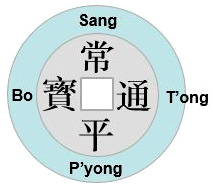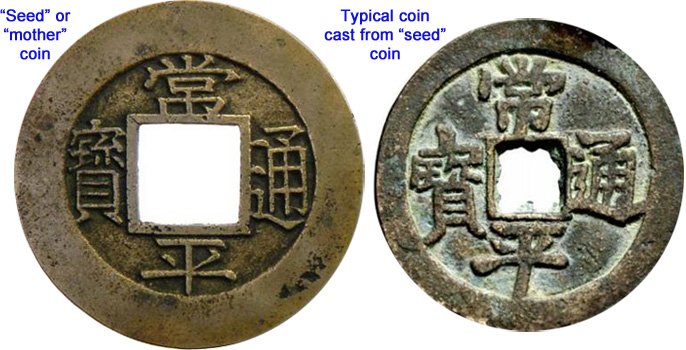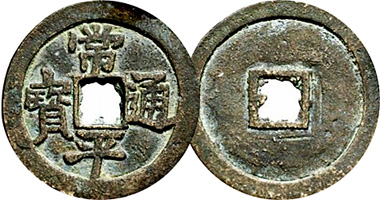Korea (Sang Pyong Tong Bo) 1, 5, and 100 Mun and Seed Coins 1633 to 1891
Hello again, Paul. You are onto an exceedingly fascinating, and hereto unexplored, area of numismatics (coin collecting): early cast coins of the Sinosphere. I don't see how these coins can do anything but go up in value. They have been laying low in numismatics for centuries, but new interest in Asain coinage is flooding the collecting universe, and major numismatics firms are opening up this market for all to enjoy. Internet technology is the primary enabler. And it's just getting started.
We can provide a little high-level information that may guide further research on your part.
One of our favorite web sites for these type coins is primaltrek. Be sure to visit.
 From the mid-1600s to the late 1800s Korea produced cast copper or bronze coins with Sang P'yong T'ong Bo logograms on the front. The meaning is always even universal currency and looking at the coin catalogs, you see these characters are found on just about every Korean coin of the era. The back of these coins may contain any of thousands of different patterns, and serious students of Korean coins have classified many of them.
From the mid-1600s to the late 1800s Korea produced cast copper or bronze coins with Sang P'yong T'ong Bo logograms on the front. The meaning is always even universal currency and looking at the coin catalogs, you see these characters are found on just about every Korean coin of the era. The back of these coins may contain any of thousands of different patterns, and serious students of Korean coins have classified many of them.
It does not take long, Paul, to scan the coin catalogs and find that there are only four major classifications that affect value strongly:
- 1 mun coins (about 24 mm diameter)
- 5 mun coins (about 32 mm diameter)
- 100 mun (about 40 mm diameter)
- seed coins
The denomination (mun) is discerned primarily by size, and 'seed' (or 'mother') coins are discerned by surface characteristics. In the side-by-side image below, the seed coin has smooth but sharp features and the 'normal' cast coin has all the tell-tale signs of casting: rough, uneven surfaces with occasional bubbles present. The seeds were used to make the molds that did the casting.

At the highest level, here are rough catalog values for these coins. These figures are based on entries from the
Standard Catalog of World Coins as well as results from recent (2011 to 2013) auctions at big-time auction houses.
1 MUN
worn: $3 US dollars approximate catalog value
average circulated: $30
well preserved: $100
5 MUN
worn: $5 US dollars approximate catalog value
average circulated: $40
well preserved: $150
100 MUN
worn: $10 US dollars approximate catalog value
average circulated: $80
well preserved: $350
SEED COINS (1 and 5 mun)
worn: $20 US dollars approximate catalog value
average circulated: $50
well preserved: $200
SEED COINS (100 mun)
worn: $100 US dollars approximate catalog value
average circulated: $200
well preserved: $500
These are very approximate catalog values. Be sure to read our Important Terminology page about what 'catalog value' means. Remember, the market for collectible Asian coins is expanding rapidly and unscrupulous individuals are very good at making counterfeits of old and crude coinage. If you are buying or selling these coins, deal only with people you trust.
cqLastNotify
Coin: 15399, Genre: The Sinosphere, Timeline: World
Created (yyyymm): 201308, Last review: 201508
Appearance: Square hole at center Metallic brown Letters: Chinese style
Years: sort: 1633, filter: 1633 to 1891
Image: korea_sang_pyong_tong_bo.jpg
Tags: slicing symbol seed mun symbal 5th symbels pyong type logograms sang centered logogram boa certer ong lining squares hole centers slash simbol 100 centre character boxes lined korean lines squarish mund symbols 6th characters bar yong korea box squared dia boxed mundos symbles 100th square off slice mundi crossbar four offcenter bars slanted holes 1st line simble one ones outlined outline slant mundo holed types tong center offset outlining


 From the mid-1600s to the late 1800s Korea produced cast copper or bronze coins with Sang P'yong T'ong Bo logograms on the front. The meaning is always even universal currency and looking at the coin catalogs, you see these characters are found on just about every Korean coin of the era. The back of these coins may contain any of thousands of different patterns, and serious students of Korean coins have classified many of them.
From the mid-1600s to the late 1800s Korea produced cast copper or bronze coins with Sang P'yong T'ong Bo logograms on the front. The meaning is always even universal currency and looking at the coin catalogs, you see these characters are found on just about every Korean coin of the era. The back of these coins may contain any of thousands of different patterns, and serious students of Korean coins have classified many of them.